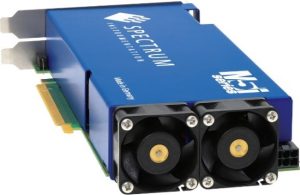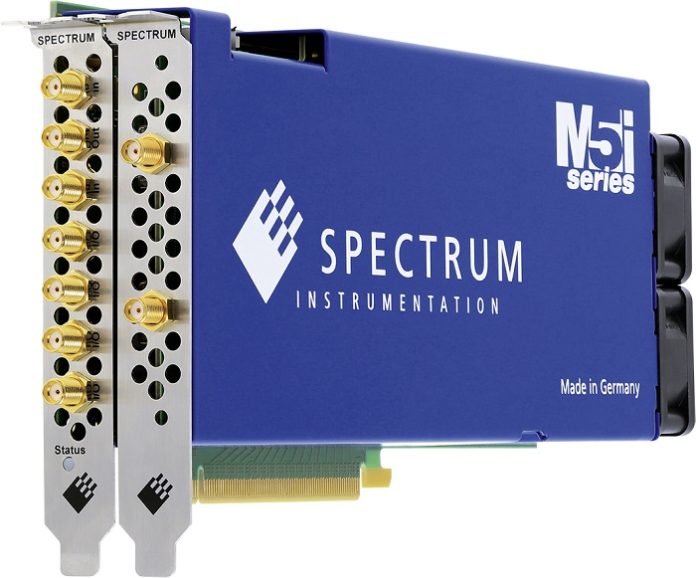The world’s first digitizers to use the full 16 lane PCIe interface (Gen 3) for massive data streaming generated huge interest in the technical media this March. The cards can stream acquired data over the bus at a staggering 12.8 GB/s, which is a transfer rate nearly twice as fast as any other PCIe digitizer currently on the market. Now Spectrum Instrumentation has released a cost-effective variant, specifically designed for dual-channel applications. The new model boasts the same blistering streaming speed and matches it perfectly with synchronous 3.2 GS/s, 12-bit sampling on each channel. This means no data needs to be lost, even when the card is acquiring data with both channels running at their maximum sampling rate. The ultrafast bus allows all the data to be transferred directly to PC memory for storage, or even to CUDA based GPUs for processing and analysis.
The new model M5i.3321-x16 is designed to handle a wide variety of signals. The unit’s fast sampling rate and high resolution are supported by fully functional front-end electronics with 1 GHz bandwidth, programmable full-scale ranges from ±200 mV to ±2.5 V and variable offset. To allow the capture of long and complex waveforms, there is a generous 4 GB (2 GSamples) of onboard memory. This can be optioned up to an industry-leading 16 GB (8 GSamples) if necessary. The onboard memory can operate as a ring buffer, like a transient recorder, or as a FIFO buffer, for streaming the acquired data directly over the bus. It can also be partitioned into segments for recording multiple events, even when they happen with very fast trigger rates. Trigger events are time stamped and a host of sophisticated triggering modes (such as software, window, re-arm, logic and delay) are available to help ensure important events are never missed.
With 12-bit resolution, the M5i.3321-x16 card offers an exceptional dynamic range. Measurements are made with improved precision and a better signal-to-noise ratio when compared to those made with more conventional 8-bit test instruments. Importantly, the extra resolution allows users to capture small signals that may ride on larger ones, revealing the fine signal details that are often missed by lower resolution devices.
Installing the card into a PC turns it into a powerful test instrument that can be used to acquire and analyse signals in a huge variety of applications. The front panel provides SMA connectors for the channel inputs, clock and trigger inputs and outputs, as well as four
 multi-functional digital I/O lines. The extra clock and trigger connections make it possible to synchronize the card with additional digitizers or other measurements
multi-functional digital I/O lines. The extra clock and trigger connections make it possible to synchronize the card with additional digitizers or other measurements

devices. The feature set makes the model very well suited for capturing the fast signals found in fibre optics, mass spectrometry, semiconductor testing, RF recording, AI, radar, LIDAR, communications, astronomy and quantum technology.
Two fans, mounted on the rear of the card, deliver perfect cooling by transporting heat out of the computer through the holes in the front plates. The design means the user does not have to worry whether the PC has enough internal airflow to adequately cool the card.
Oliver Rovini, Chief Technical Officer, said: “With the model M5i.3321-x16, we’ve created a package that optimizes the cost/performance ratio for users of our M5i family that need dual-channel signal acquisition. This new card delivers exceptional performance for anyone needing to capture and analyse signals in the MHz to GHz range. Its ability to stream data, as fast as it is acquired, directly to the PC environment opens the door for anyone wishing to use the latest CPU and GPU hardware for signal processing and analysis. For example, we’ve tested the card running at full speed and making direct RDMA data transfers to an Nvidia model RTX A4000 GPU. Once there, the GPU with its 6144 cores can perform complex functions like continuous averaging, for noise reduction, and MPoint-FFTs, for spectral analysis. That’s gapless processing of all the streamed data, even when the digitizer is sampling the incoming signals at 3.2 GS/s on both channels!”
The capability to stream data directly to a CUDA GPU is possible using the company’s SCAPP (Spectrum’s CUDA Access for Parallel Processing) package, which is available as a low-cost option. SCAPP includes the necessary drivers for CUDA GPU support and allows users to develop their own processing routines. To help get started, the package includes working examples that can be modified and built upon.
The cards come with all the tools necessary to use them on a PC running either a Windows or Linux operating system. A software development kit (SDK) is provided so that the cards can be programmed with almost any popular language. This includes C, C++, C#, Delphi, VB.NET, J#, Python, Julia, Java, LabVIEW, and MATLAB. The SDK contains all the necessary driver libraries as well as programming examples. Alternatively, for users who don’t want to write their own code, the company offers SBench 6 Professional. This powerful measurement software provides full card control, along with a host of data display, analysis, storage, and documentation capabilities.
Like all Spectrum Instrumentation products, the M5i.3321-x16 card carries a 5-year product warranty, with free software and firmware updates, as well as customer support, direct from the engineering team, for the whole lifetime of the product. The M5i.3321-x16 is available now. The new model joins two other M5i series products released in March 2022. The models are the M5i.3330-x16, a single channel card that can sample at rates up to 6.4 GS/s, and the M5i.3337-x16, a dual-channel card that offers synchronous 3.2 GS/s sampling on both channels, and the full 6.4 GS/s on a single channel. These cards offer 2 GHz bandwidth.

